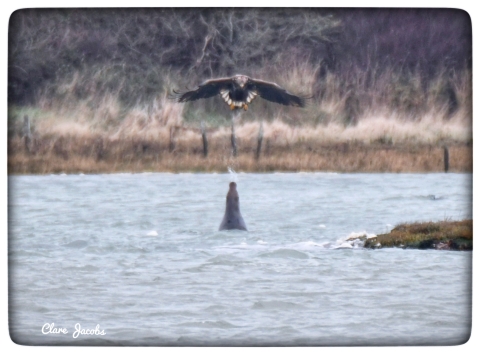A grey seal has been seen spitting a jet of water at a sea eagle, a defensive behaviour that hasn't been reported before, according to a new study from the University of Portsmouth.
The interaction sheds new light on the dynamics between these top-level predators.
The extraordinary event happened in Newtown Harbour on the Isle of Wight, when birdwatcher Clare Jacobs witnessed a white-tailed eagle swooping towards the water's surface during a high tide. As the eagle made its approach, an adult grey seal emerged from the water directly beneath the predator.
Captured on camera, the encounter showed the grey seal initially emitting barks of warning, but then resorting to an unprecedented defensive tactic: spitting a stream of water directly at the eagle.
Clare said: "I'm always thrilled to catch photos of the eagles. But catching such a rare and never before seen interaction made my year!"

A white-tailed eagle swoops towards the water's surface with an adult grey seal directly beneath. Image credit: Clare Jacobs.
Clare's daughter, Megan Jacobs, is a palaeontologist from the University of Portsmouth's School of the Environment, Geography, and Geosciences, and co-author of the study. She said: "Sightings of grey seals and white-tailed eagles are frequent events now on the Isle of Wight, but interactions between these two species have so far not been reported.
"This is the first record of an interaction between these two top predators and the first report of grey seals using spitting as a means of defence or deterrence against an aerial foe.
"The spitting may be a strategy to exclude white-tailed eagles from competing for prey as they're in direct competition for fish resources."
White-tailed eagles are the largest of all European eagles. They can achieve a maximum wingspan reaching 2.6 metres, although it is usually smaller at around 2.26m for males and 2.37 for females.
Although they became extinct on the Isle of Wight in 1780, a bold reintroduction programme began introducing young white-tailed eagles taken from Scottish breeding pairs to the Isle of Wight in the summer of 2019.

The seal is captured spitting a stream of water directly at the eagle. Image credit: Clare Jacobs.
Megan added: "Spitting is an unusual behavioural activity among vertebrates, which is why this event is so fascinating - it challenges our existing perceptions of animal defence mechanisms.
"I'm thrilled we've got photographic evidence as spitting is usually just seen in humans, camels, llamas and alpacas, as well as some snakes where it's used for venom delivery, and it can also be used for prey capture by the Archer fish."
The event was captured on a Nikon DSLR camera with a 600mm telephoto lens on the waters of the Newtown tidal estuary of the Newtown River on a stretch of water called Clamerkin Brook or Clamerkin Lake during high tide.
The paper is published in the Isle of Wight Natural History and Archaeological Society journal.






